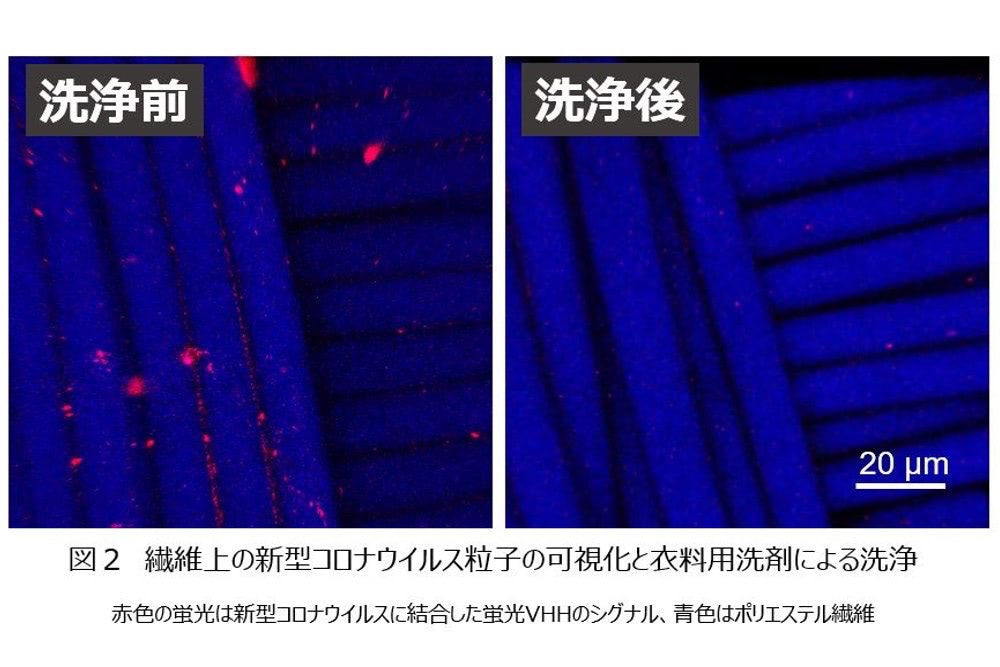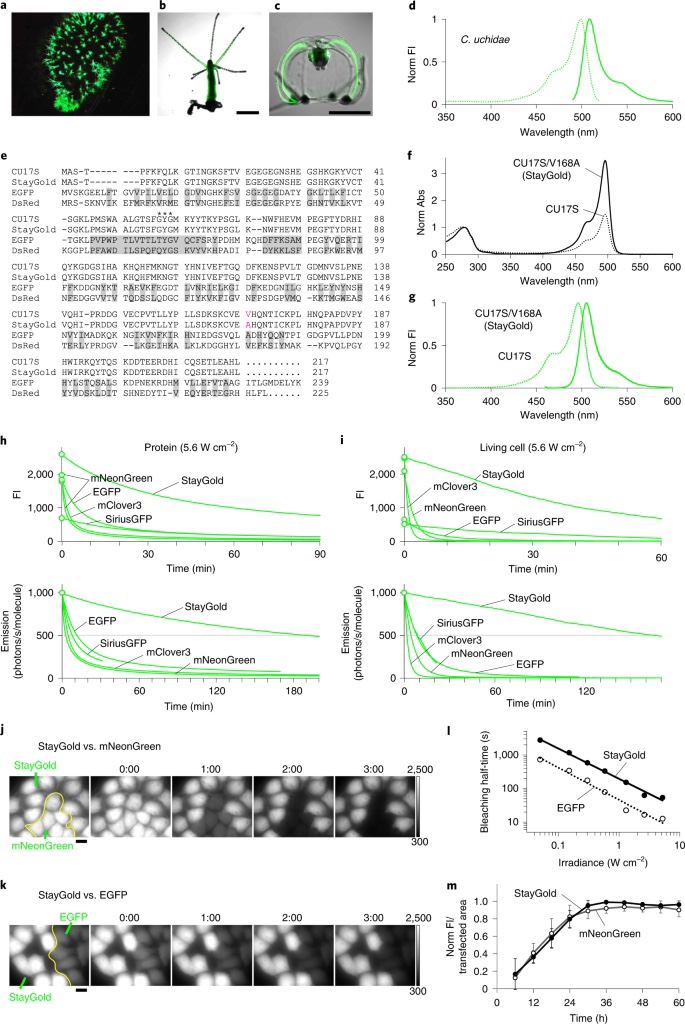

新型冠狀病毒:精細可視化!
– 花王製備染色病毒顆粒 –
花王:
-與新型冠狀病毒結合的VHH抗體-
使用“與高強度熒光蛋白連接的融合蛋白”,
我們一直在研究“在新型冠狀病毒診斷中的應用”。
準備染色的病毒顆粒:
我們已經為環境中的病毒開發了一種簡單的可視化技術。
新冠病毒:
用多聚甲醛處理。
感染性消除後,對病毒 RNA 進行染色。
添加 SYTO82,這是一種與 S 蛋白結合的 KikG 融合 VHH 抗體。
準備染色的病毒顆粒。
附著在紡織品上的病毒:
將製備好的病毒顆粒滴在滌綸布上,使病毒附著在纖維上。
在熒光顯微鏡下觀察:
用熒光顯微鏡觀察。
在纖維上
病毒衍生熒光 (SYTO82) 和 KikG 融合 VHH 抗體衍生熒光
在同一位置檢測到。
病毒顆粒的可視化:
這個結果是
附著在纖維上的病毒顆粒從融合了 KikG 的 VHH 抗體中發出明亮的熒光,
它表明它是可視化的。
用洗衣液洗:
我用洗衣液清洗了帶病毒的布。
來自 KikG-VHH 融合蛋白的熒光
證實它從纖維顯著減少。
這個測試:
“即使在紡織品上也可以看到病毒的可能性”。
直到現在,它只能通過電子顯微鏡來確認。
環境中的病毒顆粒:
“高亮度/熒光蛋白”和“具有高結合能力的VHH抗體”
通過結合,可以很容易地觀察到病毒顆粒。
福布斯日本官方網站
https://forbesjapan.com/articles/detail
Nouveau coronavirus : belle visualisation !
– Kao prépare des particules virales colorées –
Kaô :
-Anticorps VHH qui se lie au nouveau coronavirus-
En utilisant “une protéine de fusion liée à une protéine fluorescente de haute intensité”,
Nous étudions “l’application au diagnostic du nouveau coronavirus”.
Préparez les particules virales colorées :
Nous avons développé une technologie simple de visualisation des virus dans l’environnement.
Coronavirus nouveau:
Traiter avec du paraformaldéhyde.
L’ARN viral est coloré après élimination de l’infectiosité.
Ajouter SYTO82, un anticorps VHH fusionné avec KikG qui se lie à la protéine S.
Préparer les particules virales colorées.
Virus attaché aux textiles :
Les particules virales préparées ont été déposées sur un tissu en polyester pour attacher le virus à la fibre.
Observé au microscope à fluorescence :
Observé au microscope à fluorescence.
sur la fibre
Fluorescence dérivée du virus (SYTO82) et fluorescence dérivée de l’anticorps VHH fusionné avec KikG
détecté au même endroit.
Visualisation des particules virales :
Ce résultat est
Les particules virales attachées à la fibre sont brillamment fluorescentes à partir de l’anticorps VHH fusionné avec KikG,
Cela montre qu’il est visualisé.
Laver avec un détergent à lessive :
J’ai lavé le chiffon infecté par le virus avec un détergent à lessive.
Fluorescence dérivée de la protéine de fusion KikG-VHH
Il est confirmé qu’elle diminue significativement à partir de la fibre.
Ce test:
“Possibilité de visualiser des virus même sur des textiles” a été démontrée.
Jusqu’à présent, cela ne pouvait être confirmé qu’au microscope électronique.
Particules virales dans l’environnement :
“Protéine à haute luminosité/fluorescente” et “anticorps VHH avec une capacité de liaison élevée”
En se liant, les particules virales peuvent être facilement observées.
Forbes JAPON Site officiel
Novel Coronavirus: Feine Visualisierung!
– Kao bereitet gefärbte Viruspartikel vor –
Kao:
-VHH-Antikörper, der an das neuartige Coronavirus bindet-
Verwendung “eines Fusionsproteins, das mit einem hochintensiven fluoreszierenden Protein verbunden ist”,
Wir haben die „Anwendung zur Diagnose des neuen Coronavirus“ untersucht.
Bereiten Sie gefärbte Viruspartikel vor:
Wir haben eine einfache Visualisierungstechnologie für Viren in der Umgebung entwickelt.
Neuartiges Coronavirus:
Mit Paraformaldehyd behandeln.
Virale RNA wird gefärbt, nachdem die Infektiosität eliminiert wurde.
Fügen Sie SYTO82 hinzu, einen KikG-fusionierten VHH-Antikörper, der an das S-Protein bindet.
Bereiten Sie gefärbte Viruspartikel vor.
An Textilien haftende Viren:
Die hergestellten Viruspartikel wurden auf ein Polyestertuch getropft, um das Virus an der Faser zu befestigen.
Unter einem Fluoreszenzmikroskop beobachtet:
Beobachtet mit einem Fluoreszenzmikroskop.
auf der Faser
Virus-abgeleitete Fluoreszenz (SYTO82) und KikG-fusionierte VHH-Antikörper-abgeleitete Fluoreszenz
an der gleichen Stelle erkannt.
Visualisierung von Viruspartikeln:
Dieses Ergebnis ist
An der Faser anhaftende Viruspartikel fluoreszieren hell vom KikG-fusionierten VHH-Antikörper,
Es zeigt, dass es visualisiert wird.
Mit Waschmittel waschen:
Ich habe das virusbehaftete Tuch mit Waschmittel gewaschen.
Fluoreszenz stammt von KikG-VHH-Fusionsprotein
Es wird bestätigt, dass es von der Faser signifikant abnimmt.
Dieser Test:
„Möglichkeit Viren auch auf Textilien zu visualisieren“ wurde gezeigt.
Bisher konnte es nur mit einem Elektronenmikroskop bestätigt werden.
Viruspartikel in der Umwelt:
„High-Brightness/Fluoreszenz-Protein“ und „VHH-Antikörper mit hoher Bindungsfähigkeit“
Durch die Bindung können Viruspartikel leicht beobachtet werden.
Offizielle Seite von Forbes JAPAN
Kao | A Highly Photostable Fluorescent Protein
– Technology That Allows For Quantitative Observation of Cellular Microstructures and Viruses –
A joint research group consisting of researchers from
the Laboratory for Cell Function Dynamics of the RIKEN Center for Brain Science
the Biotechnological Optics Research Team of the RIKEN Center for Advanced Photonics;
the Asamushi Research Center for Marine Biology, Graduate School of Life Sciences, Tohoku University;
the Ōmura Satoshi Memorial Institute, Kitasato University;
the Safety Science Research Laboratories,
Kao Corporation,
promotes sustainable bioimaging by utilizing a jellyfish-derived green fluorescent protein StayGold, which is bright and exhibits minimal fading.
StayGold improves
spatiotemporal resolution and dramatically extends the observation period.
This finding offers
a new and powerful tool for the bioimaging community,
in which most experimenters encounter the challenging issue of photobleaching[1] of fluorescent proteins.
On the basis of gene expression[2] analysis of the jellyfish Cytaeis uchidae[3] done by
researchers from Tohoku University, researchers from RIKEN created StayGold, a bright fluorescent protein variant with the unique property of minimal photobleaching,
through their molecular cloning and mutagenesis studies on a wild-type fluorescent protein.
Fluorescent labelling of organelles such as
the endoplasmic reticulum, mitochondria,
and microtubules with StayGold
has revealed dynamic structural changes that could not be observed previously due to the photobleaching of conventional fluorescent proteins.
In addition, StayGold was molecularly linked to the anti-Spike VHH antibody[4]
developed by researchers from
Kitasato University and Kao Corporation to visualize the process of virion maturation in SARS-CoV-2-infected cells,
which is appealing to scientists in medicine who are working furiously to develop ways to reliably detect SARS-CoV-2 and other infectious viruses.
These findings were reported in Nature Biotechnology Online (published on April 25).
https://www.kao.com/global/en/news/rd/2022/20220708-002/
A highly photostable and bright green fluorescent protein | Nature Biotechnology